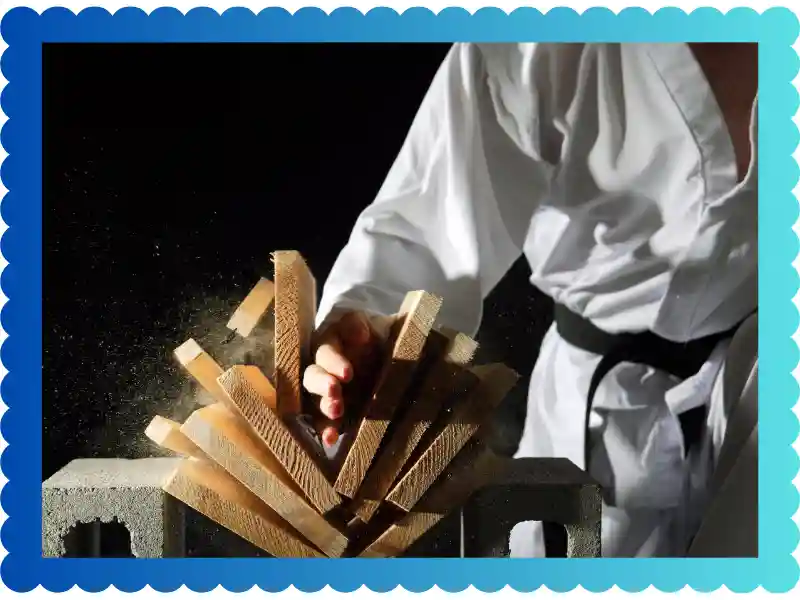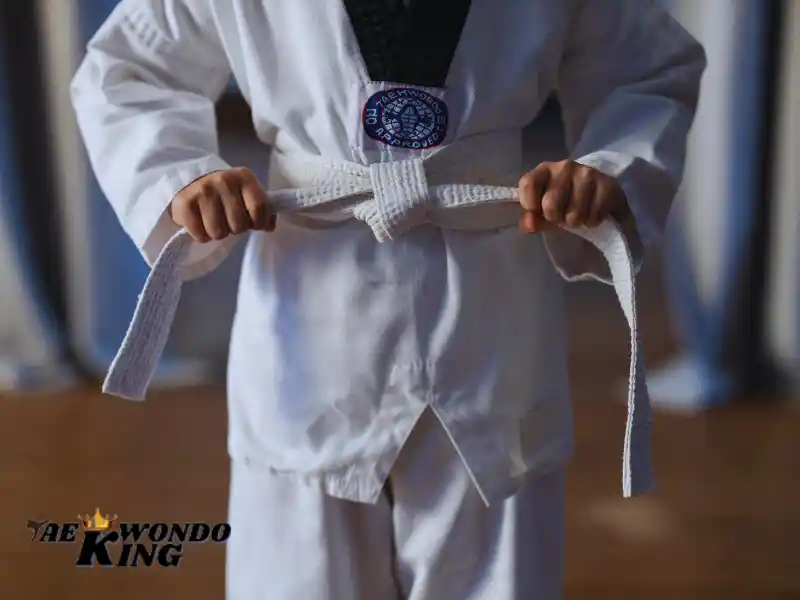
Breaking boards looks cool. I still remember the first time I saw someone break a board in Denver. My jaw dropped. I thought, “How did they do that?” Now, after years of practice, I know the secret. It’s not about being super strong. It’s about using the right taekwondo breaking technique.
Let me share what I’ve learned at Taekwondoking about board breaking. This guide will help you break boards safely and build your confidence.
What Is Board Breaking in Taekwondo?
Board breaking is a core skill in taekwondo. We call it “Kyukpa” in Korean. It tests your focus, power, and technique all at once.
You strike a wooden board with your hand, foot, or elbow. The board snaps in two. Simple, right? Not quite.
Breaking boards teaches you more than just power. It shows you how your body works. You learn to focus your mind. You discover what you can really do.
At Taekwondoking, we use board breaking to measure progress. It’s a physical test. But it’s also mental. Your brain needs to believe you can do it before your body follows through.
Why Do We Break Boards?
Board breaking serves many purposes:
- Tests your technique: Bad form won’t break the board
- Builds confidence: Success feels amazing
- Shows progress: You can see your improvement
- Trains focus: Your mind must be sharp
- Demonstrates power: Technique creates real force
Many students ask me, “Why not just hit a bag?” Good question. Bags don’t give you instant feedback. A broken board proves your technique worked.
See the latest Top-Rated Adjustable Dumbbells Set Price Today Used by Champions.

The Science Behind Breaking Boards
Here’s what most people get wrong. They think you need huge muscles. You don’t.
Breaking boards is about physics. You need speed, proper form, and focus. That’s it.
How Breaking Actually Works
When you strike a board, you create stress. This stress spreads through the wood. The board breaks at its weakest point.
Your hand or foot acts like a hammer. But speed matters more than size. A fast strike with good form beats a slow, strong one every time.
Think about this formula: Force = Mass x Acceleration
Your mass stays the same. But you can increase your acceleration. That’s where technique comes in.
The Role of Focus and Mind
Your brain controls everything. If you hesitate, you’ll fail. Your body pulls back. You don’t follow through.
I teach students at Taekwondoking to aim past the board. Don’t aim at the board. Aim through it. This mental trick changes everything.
Visualization helps too. See the board breaking before you strike. Your mind creates a path. Your body follows.
Essential Safety Rules for Board Breaking
Safety comes first. Always. I’ve seen students hurt themselves by rushing. Don’t be that person.
Pre-Breaking Safety Checks
Check these things before every break:
- Your board is the right thickness
- No cracks or weak spots exist
- Your hands and feet are warm
- You’ve stretched properly
- Someone is holding the board correctly
Never break boards when you’re tired. Tired muscles don’t work right. You risk injury.
Common Injuries and How to Avoid Them
The most common injuries I see are:
- Bruised knuckles: From poor hand position
- Sprained wrists: From bent wrists at impact
- Jammed fingers: From hitting at the wrong angle
- Foot bruises: From incorrect striking surface
Here’s how to prevent these:
Use the right striking surface. For hand breaks, hit with the bottom two knuckles. For foot breaks, use the ball of your foot or your heel.
Keep your joints locked at impact. A bent wrist or ankle absorbs the force instead of transferring it.
Start with thin boards. Work your way up slowly. Pride isn’t worth a broken bone.
Types of Taekwondo Breaking Techniques
Taekwondo offers many breaking techniques. Each one uses different body parts and movements.
Hand Techniques
Knife Hand Strike (Sudo)
This is the classic karate chop. You use the side of your hand. The meat between your pinky and wrist hits the board.
Keep your fingers tight together. Your thumb tucks in. Strike with speed and snap your hand back quickly.
Hammer Fist
You make a fist and swing down like a hammer. The bottom of your fist hits the board.
This technique works great for downward breaks. It’s safer for beginners because your bones are protected.
Reverse Punch (Bandae Jirugi)
A straight punch using your rear hand. Your first two knuckles make contact.
Twist your hips for power. Keep your wrist straight. This technique needs good form to work safely.
Foot Techniques
Front Kick (Ap Chagi)
You strike with the ball of your foot. Pull your toes back. This protects them from injury.
Chamber your knee high. Extend fast. Snap your leg back after impact.
Side Kick (Yop Chagi)
The most powerful breaking technique. You strike with your heel or the blade of your foot.
Turn your hips. Your body should be sideways. Drive through the target with your whole body weight.
I’ve broken three boards at once using this kick at Taekwondoking. It takes practice, but it works.
Roundhouse Kick (Dollyo Chagi)
You hit with the top of your foot or shin. This kick comes from the side in a circular motion.
Pivot on your standing foot. Your hips turn over. Speed is everything here.
Axe Kick (Naeryo Chagi)
You lift your leg high and drop it down. Your heel strikes the board from above.
This technique looks impressive. It takes flexibility and control. Work on your stretching first.
Elbow and Knee Techniques
Elbow Strike
You can use a downward, side, or backward elbow. The point of your elbow hits the target.
These breaks are powerful but risky. Only try them after mastering hand and foot techniques.
Knee Strike
You drive your knee upward or forward. This works for breaks held at waist level.
Grab the board holder for stability. Focus all your power into a small point.
Choosing the Right Breaking Boards
Not all boards are the same. The type and thickness matter a lot.
Board Types and Specifications
| Board Type | Thickness | Best For | Difficulty |
|---|---|---|---|
| Pine | 1/2 inch | Beginners | Easy |
| Pine | 1 inch | Intermediate | Medium |
| Oak | 1/2 inch | Advanced | Hard |
| Rebreakable | Various | Practice | Adjustable |
Pine is the standard. It breaks cleanly and doesn’t hurt as much. Oak is harder and used for demonstrations.
Rebreakable Boards vs. Wood
Rebreakable boards are plastic boards you can use many times. They’re great for practice.
Real wood gives you the authentic experience. It feels different. The sound is better. Wood also teaches you about real resistance.
At Taekwondoking, we use both. Practice with rebreakable boards. Test with real wood.
Board Grain Direction
Always break with the grain, not against it. The grain lines show which way the wood fibers run.
Hold the board so the grain runs vertically. This makes it easier to break. Breaking against the grain is much harder and can hurt you.
See the latest Top-Rated Adjustable Dumbbells Set Price Today Used by Champions.

Step-by-Step Breaking Technique
Let me walk you through a basic board break. We’ll use a knife hand strike as our example.
Proper Stance and Body Positioning
Start in a fighting stance. Your feet are shoulder-width apart. Your weight is balanced.
Face the board directly. Your shoulders stay level. Don’t lean too far forward or back.
Hand and Foot Positioning
For a knife hand strike:
- Make your hand flat and rigid
- Keep your fingers together
- Tuck your thumb
- Your striking edge faces the board
For foot breaks, pull your toes back. Point your heel. Keep your ankle locked.
The Strike: Chamber, Execute, Follow-Through
Chamber: Pull your hand or foot back. This loads your power.
Execute: Strike fast. Don’t slow down at impact. Aim past the board.
Follow-Through: Keep moving through the break. Your hand or foot should end up on the other side of where the board was.
This three-step process is crucial. Miss one step and you’ll fail.
Breathing Technique
Breathe out sharply as you strike. We call this a “kihap” or spirit yell.
This does three things:
- Tightens your core
- Focuses your energy
- Prevents you from holding your breath
Try it. Break with a yell. Then try it silently. You’ll feel the difference.
Training Progression for Beginners
Don’t rush. Building skill takes time. Here’s how I teach students at Taekwondoking.
Conditioning Your Hands and Feet
Start by toughening your striking surfaces. Do push-ups on your knuckles. Practice strikes on padded targets.
Gradually increase resistance. Your bones and skin need time to adapt.
I spent three months conditioning before my first break. It felt slow then. But it kept me safe.
Building Speed and Power
Speed comes from technique, not muscle. Practice your forms regularly. Focus on snapping your taekwondo breaking techniques.
Power comes from your whole body. Use your hips. Turn your shoulders. Your arm or leg is just the delivery system.
Try this drill: Strike a heavy bag with proper form. Count how many times you can do it in 30 seconds. Improve your speed each week.
Mental Preparation
Fear is normal. The first break is scary. That’s okay.
Visualize success. See yourself breaking the board cleanly. Feel the board split under your strike.
Remove doubt. If you think “what if I fail?” you probably will. Replace it with “I will break this board.”
I’ve taught hundreds of students. The ones who commit mentally always succeed. The ones who hesitate always struggle.
Common Mistakes and How to Fix Them
Everyone makes mistakes. Here are the big ones I see.
Pulling Your Strike
This is the number one mistake. You aim at the board instead of through it.
Fix: Place a target six inches behind the board. Aim for that target, not the board.
Incorrect Striking Surface
Hitting with the wrong part hurts. It also doesn’t break the board.
Fix: Mark your striking surface with a marker. Check it after each practice strike.
Poor Body Alignment
Your body parts don’t line up. Your power leaks out.
Fix: Have someone watch you. Film yourself. Check that everything moves in a straight line.
Hesitation
You slow down right before impact. Your brain takes over.
Fix: Count down: “Three, two, one, BREAK!” Don’t give yourself time to think.
Advanced Breaking Techniques
Once you master basic breaks, you can try harder stuff.
Speed Breaks
You hold the board yourself. You strike it while it’s moving. This tests your timing and precision.
Speed breaks are common in demonstrations. They look impressive and require excellent control.
Power Breaks
You stack multiple boards. Then you break them all at once.
I’ve broken five boards with a side kick. It took years of practice. Start with two boards and work up slowly.
Aerial Breaks
You jump in the air and break the board mid-flight. Flying side kicks and spinning kicks work well.
These breaks combine athleticism with technique. They’re flashy but risky. Only attempt them after years of training.
Creative Breaking
You can break boards in creative ways:
- Blindfolded breaks
- Breaking while in a split
- Breaking boards held at odd angles
- Breaking with unusual techniques
These demonstrations show mastery. They’re fun but not essential for learning.
Board Breaking for Testing and Demonstrations
Many schools, including Taekwondoking, use board breaking in belt tests.
Belt Test Requirements
Different belts require different breaks. Here’s a typical progression:
- Yellow Belt: One board, front kick
- Green Belt: One board, side kick
- Blue Belt: Two boards, choice of technique
- Red Belt: Three boards or speed break
- Black Belt: Multiple techniques and boards
These requirements vary by school. Always follow your instructor’s guidelines.
Demonstration Tips
If you’re breaking boards in front of an audience:
- Practice your exact setup beforehand
- Warm up thoroughly
- Focus on your technique, not the crowd
- Breathe and commit to your strike
I performed at a demonstration in Denver last year. The crowd of 200 people made me nervous. But I focused on my breathing. The boards broke cleanly.
Equipment and Setup
Having the right equipment makes everything easier.
What You Need
Here’s your shopping list:
- Breaking boards (appropriate thickness)
- Board holders or a partner
- Hand and foot protection (optional)
- First aid kit
- Stretching mat
You don’t need much. Taekwondo stays simple.
Proper Board Holding Technique
If someone holds your board:
- They grip the top and bottom edges firmly
- Their arms are straight and locked
- They look away to protect their face
- They stay rigid and don’t pull back
Bad holding causes more failures than bad technique. Practice this part too.
Setting Up Breaking Stations
For group practice, set up multiple stations. This keeps everyone active.
Space stations at least 10 feet apart. Use mats around each station. Have an instructor supervise each area.
Benefits Beyond Breaking Boards
Board breaking teaches life lessons. These apply outside the dojang.
Confidence Building
Each successful break proves you can do hard things. This confidence spreads to other areas.
Students tell me breaking boards helped them:
- Ask for a promotion at work
- Stand up to bullies
- Try new activities
- Face their fears
Focus and Concentration
You can’t break a board while distracted. You learn to shut out everything else.
This skill helps with:
- Studying for tests
- Working on difficult projects
- Solving complex problems
- Staying calm under pressure
Goal Setting and Achievement
Breaking boards teaches you how to set goals and reach them.
You start with thin boards. You work up to thick ones. Also, You see your progress clearly.
This same method works for any goal. Break it into smaller steps. Master each step. Celebrate progress.
See the latest Top-Rated Adjustable Dumbbells Set Price Today Used by Champions.

People Asked Questions
Does breaking boards hurt?
It can hurt if you do it wrong. With proper technique, it shouldn’t hurt much. You might feel a slight sting, but no real pain.
Can kids break boards?
Yes! Kids as young as six can break boards safely. They use thinner boards and proper supervision. At Taekwondoking, we have special boards just for children.
How thick should my first board be?
Start with a 1/2 inch pine board. This thickness is perfect for learning. You can progress to thicker boards as you improve.
What if I can’t break the board?
Don’t worry. Almost everyone fails their first few tries. Check your technique. Make sure you’re striking the right spot. Commit fully to your strike. Try again.
Can I practice at home?
Yes, but be careful. Use rebreakable boards for home practice. Make sure you have enough space. Have someone help you hold the board.
Conclusion
Breaking boards is one of the most rewarding parts of taekwondo. It looks impressive. It feels amazing. Also, It teaches valuable lessons.
Remember these key points:
- Safety always comes first
- Technique beats strength every time
- Mental commitment is essential
- Start small and progress slowly
- Practice makes perfect
I’ve been teaching taekwondo breaking techniques for over a decade. I’ve seen students transform through this practice. They come in nervous. They leave confident.
You can do this too. Start with thin boards. Focus on form. Trust your training. Before long, you’ll be breaking boards like a pro.
At Taekwondoking, we believe anyone can learn board breaking. It doesn’t matter if you’re young or old, strong or weak. What matters is your willingness to learn and practice.
So grab a board. Set it up properly. Take a deep breath. And break through your limits.
You’ve got this.
FAQs
The key to easily breaking wood is speed and focus. You must hit the target with a lot of speed. You also need to concentrate all the force of your strike into a very small area.
No, board breaking is not fake. It is a real demonstration of power, focus, and proper technique. The wood boards are thin but solid.
The five rules of Taekwondo are the five tenets, which are moral guidelines. They are courtesy, integrity, perseverance, self-control, and indomitable spirit.
“Hardest” is a matter of opinion, but Muay Thai is often called one of the hardest. It uses the body as eight weapons. Styles that require high levels of balance and flexibility, like extreme Taekwondo, are also very challenging.
The board holder should grip the sides of the board firmly. They must hold the board level and flat so it does not move backward when struck. The holder’s thumbs should be on the top edge of the board.
The five basic skills are generally considered to be kicks, blocks, punches, strikes, and stances. Mastery of all five is needed for good practice.
The hardest moves are often the athletic spinning kicks or jumping kicks. The 540 degree turning kick is extremely difficult. These moves need a lot of speed, balance, and coordination.
Neither is better; it depends on what you want. WTF (World Taekwondo) is better if you want to focus on sport fighting and the Olympics. ITF is better if you prefer more traditional forms and self-defense techniques.
The trick is to not focus on the surface of the board. Focus your mind and energy through the board. You must commit to sending your hand or foot past the target.
The three elements of good breaking are speed, mass, and focus. You need speed for impact, mass for power, and focus to hit the correct small spot.
See the latest Top-Rated Adjustable Dumbbells Set Price Today Used by Champions.


Founder, Owner, and CEO of TaekwondoKing.
He is one of the top 100 martial artists in the World and among the top 20 referees in Bangladesh.
Ehatasamul Alom is an esteemed Kukkiwon Certified Taekwondo 3rd Dan Black Belt with over 15 years of experience in this dynamic martial art. Born in Rajshahi, Bangladesh, Ehatasamul’s journey with Taekwondo began at the tender age of seven. His passion led him to compete at national and international levels, where he has bagged numerous awards and honors. He is also a member of the Taekwondo National Referee Panel.
With a Bachelor’s degree in Sports Science from the prestigious Rajshahi University, Ehatasamul has a deep understanding of the technical and scientific aspects of martial arts and some other martial arts.
In 2022, Ehatasamul created the “TaekwondoKing.com” to share his knowledge, Free Resources, Values, and Real experiences. His articles focus on Taekwondo training techniques, competition strategies, Sport Products Reviews, and the art’s rich history and philosophy. He also writes about the importance of mental fortitude and discipline, key aspects of his teaching philosophy. He has already launched many sports, Taekwondo, and health-related Free online tools. His goal is to inspire both beginners and seasoned practitioners worldwide through insightful and engaging content.
If you need any help, contact Ehatasamul Alom at any time.




